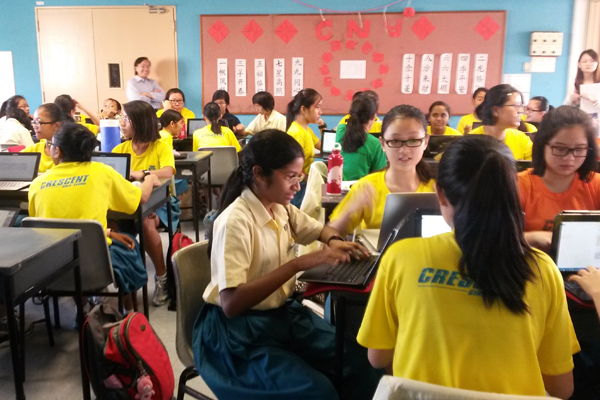O estudo mede competências em leitura, matemática e solução de problemas tecnológicos; primeira edição foi realizada entre 2008 e 2013
29 de abril de 2014 | 22h 05
Bárbara Ferreira Santos - O Estado de S. Paulo
SÃO PAULO - O Brasil estuda participar de uma prova da Organização para Cooperação e Desenvolvimento Econômico (OCDE) semelhante ao Programa Internacional de Avaliação de Estudantes (Pisa), principal avaliação do ensino básico do mundo, mas voltada para adultos. Os resultados do primeiro estudo do Programa Internacional para Avaliação das Competências de Adultos (PIAAC), voltado para pessoas de 16 a 65 anos, foram anunciados nesta terça-feira, 29, em Brasília.
O teste mede habilidades em leitura, matemática e solução de problemas tecnológicos entre adultos. A primeira edição foi realizada entre 2008 e 2013 e aplicada em 23 países: Alemanha, Austrália, Áustria, Bélgica, Canadá, Coreia, Dinamarca, Espanha, Estados Unidos, Estônia, Rússia, Finlândia, França, Irlanda, Itália, Japão, Noruega, Holanda, Polônia, Reino Unido, República Tcheca, Eslováquia e Suécia.O Instituto Nacional de Estudos e Pesquisas Educacionais Anísio Teixeira (Inep) não confirmou a participação na segunda edição, que deve ser concluída em 2016, mas afirma que está estudando sobre a prova para saber se vai ou não participar. Chile, México, Colômbia, Argentina e Equador devem fazer parte da segunda prova.
O estudo coletou informações sobre como essas competências são empregadas no dia a dia e como são desenvolvidas, mantidas e perdidas com o passar do tempo. Segundo Andreas Schleicher, diretor-adjunto de Educação da OCDE, a prova não só mede o desempenho individual, mas mapeia como ele impacta na economia e na sociedade. "Pessoas com os níveis mais altos têm mais chances de conseguir bons trabalhos e têm boas chances de ser mais saudáveis, de participar de políticas públicas e de participar de voluntariado, por exemplo. Queremos entender como a economia traduz melhores habilidades em melhores trabalhos e melhores condições de vida. Não é um teste sobre indivíduos. É sobre o papel que as habilidades têm na economia e na sociedade".
Educação básica. Para Schleicher, esse tipo de prova consegue mapear algumas barreiras da educação básica que se perpetuam na vida adulta. Diferentemente do Pisa - que não leva em conta as notas das escolas das zonas rurais brasileiras -, este estudo deve ser aplicado em pessoas de diferentes regiões e de diferentes estratos sociais. "Como não são pessoas que estão na escola, pega pessoas em toda a sociedade. Vendo esse retrato poderemos ver o que será possível fazer em termos de políticas públicas. Nós só conseguimos melhorar o que medimos".
Ele explica que quem tem uma base boa na educação básica tem mais chances de continuar aprendendo ao longo da vida. "As pessoas que são bem educadas na escola continuam estudando durante a vida, continuam a ler. Mas as pessoas que não desenvolvem as habilidades básicas nas escolas continuam aprendendo menos, participam menos dos treinamentos e a barreira não só continua como aumenta na vida adulta".
O estudo mapeou que o nível das habilidades (que vai de 1 a 5, do menor para o maior) está relacionado com as oportunidades de emprego. O salário médio por hora dos trabalhadores com pontuação no nível 4 ou 5 (os mais altos) em letramento - aqueles que conseguem fazer inferências complexas e avaliar a veracidade de proposições ou argumentações em textos escritos - é mais que 60% maior que o de trabalhadores com pontuação no nível 1 ou menor - aqueles que conseguem, no máximo, ler textos relativamente curtos para localizar uma única informação que é idêntica à informação dada em uma pergunta ou instrução, ou possuem um vocabulário básico. Aqueles com baixa competência em letramento também têm duas vezes mais chances de ficarem desempregados.
De acordo com Schleicher, essas habilidades podem ser perdidas ao longo do tempo, se não usadas. "Isso acontece particularmente com os mais jovens. Os jovens que não usam essas habilidades acabam as perdendo. Isso mostra como é importante obter, após o período escolar, bons trabalhos nos quais se possa usar suas habilidades", afirma. "É papel do indivíduo ser seu próprio professor durante a vida, querendo aprender, mas empregadores podem criar ambientes que propiciem o aprendizado no dia a dia e governantes devem criar políticas públicas para garantir a educação de qualidade."








